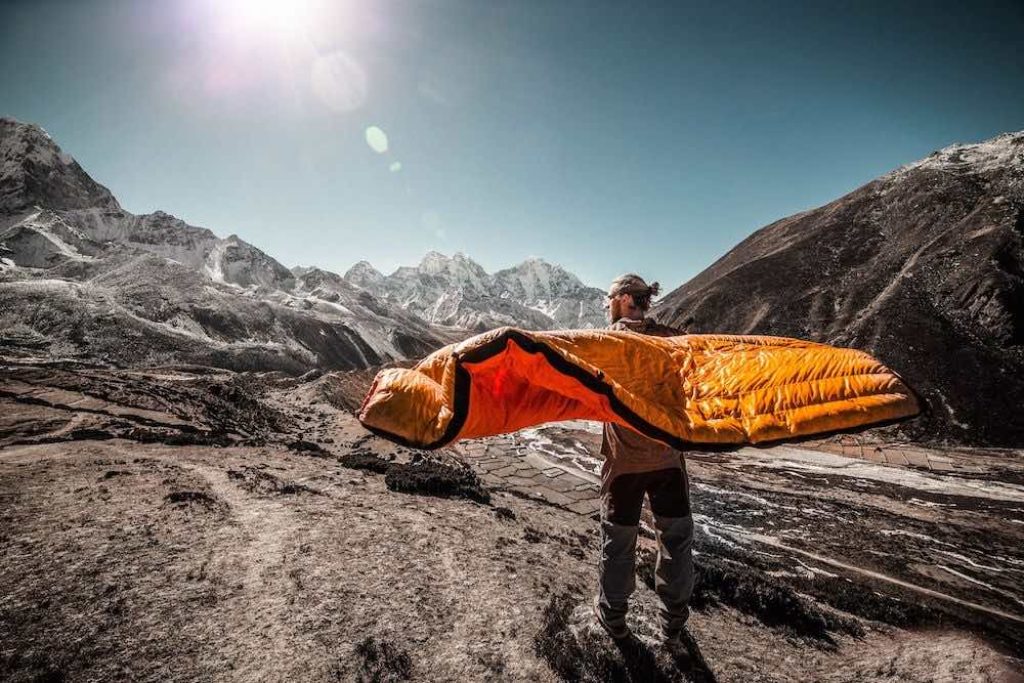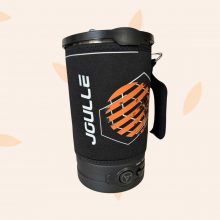
Looking for an eco-friendly option for your next camping adventure? Sleeping bags are a fundamental piece of gear, but many don’t realize they often contain PFAs and PFCs, which are chemicals that can have potential risks to both humans and the environment.
This guide provides an overview of PFA/PFC chemicals, and a list of PFA/PFC-free sleeping bags for campers and outdoor gear heads.
Key Takeaways:
- Sleeping bags often contain PFAs/PFCs, which pose potential risks to human health and the environment.
- PFAs and PFCs are man-made chemicals used in various industries for water repellency and heat resistance.
- PFAs and PFCs persist in the environment and can have adverse health effects, including endocrine disruption.
- This guide provides an overview of PFAs and PFCs to help consumers understand what these chemicals are and how they work.
- This article provides a list of PFA/PFC-free sleeping bags.
What are PFAs (Perfluoroalkyl substances) and PFCs (Perfluorocarbons)?

Perfluorinated and Polyfluoroalkyl chemicals, commonly known as PFCs or PFAs, are frequently used in outdoor gear, including sleeping bags, to repel water, dirt, and oil from treated fabrics. However the CDC and other scientific organizations have linked PFCs and PFAs to various health issues, such as hormone disruption, developmental problems in children, and even cancer.
Perfluoroalkyl substances (PFAs) and perfluorocarbons (PFCs) are a group of man-made chemicals used in various industries, including the production of fluoropolymer coatings and products that resist heat, oil, and stains.
They’ve earned their nickname “forever chemicals” because of their persistence in the environment and resistance to degradation. These compounds have become increasingly concerning due to their potential for adverse health effects on humans via endocrine disruption as well as reports linking exposure with pregnancy-induced hypertension and reduced birth weight.
PFAs can accumulate in the food chain gradually entering our bodies through eating contaminated foods or drinking contaminated water which means these environmental pollutants may be subjecting us to long-term health risks like weakening the body’s response to vaccinations.
Why should we avoid PFAs and PFCs?

Perfluoroalkyl substances (PFAs) and perfluorocarbons (PFCs) are man-made chemicals used in a wide range of industries, including the textile industry. These chemicals are widely used in certain types of winter gear, such as sleeping bags, tents and lunch boxes, to improve their water repellency.
Despite these benefits, PFAs and PFCs have been linked to significant environmental contamination through leaching into the aquifer from manufacturing processes or shedding off clothes during use.
This has subsequently resulted in their accumulation throughout the food chain with possible adverse impacts on human health. Studies have shown that exposure to certain levels of PFAs can cause liver damage while higher exposure could be toxic.
Additionally, long term contact with a related group of compounds known as Per-and PolyFluoroAlkyl Substances (PFASs) has been correlated with immune system disruption and developmental delays in children.
This is not to say that using products with PFCs and PFAs are going to immediately harm you or make you sick. However, a large body of the medical research on the subject indicates that reducing exposure to these chemicals is better, especially for children and immunocompromised people.
PFA / PFC-Free Sleeping Bags Comparison Table
For quick recommendation, check out our comparison table below or scroll down for more comprehensive reviews.
| Product | Price | Material | Temperature Limit | Shape |
|---|---|---|---|---|
| Therm-a-Rest Questar 0F | $469 – $317 | Polyester | 0°F (-18°C) | Mummy |
| Rab Solar Eco 0 | $122 – $150 | Polyester | 40°F (4.4°C) | Mummy |
| VAUDE Sioux 400 | $106 – $140 | Polyester | 37°F (3°C) | Mummy |
| Exped MegaSleep 25F | $99 – $229 | Synthetic | 25°F (3.89°C) | Rectangular |
| Sierra Designs Get Down 35 | $179 – $199 | Polyester | 11°F (-11.67°C) | Mummy |
| Kelty Cosmic 20F | $123 | Nylon, Poly Taffeta | 20°F (-6.7°C) | |
| Mummy |
PFA / PFC-Free Sleeping Bags
1. Therm-a-Rest Questar 0F
- The cold-weather winter sleeping bag in...
- 650 fill Nikwax Hydrophobic Down absorbs 90% less...
- With Additional Room for Multiple positions...
- SynergyLink Connectors integrate the bag with a...
- Long left-zip bag measures 85x33x5.5 inches, fits...
Features
- Temperature Limit: 0°F / -18°C
- Style: Mummy
- Fabric: Made of 20D ripstop polyester fabric with a water-repellent finish
- Weight: 2.56lbs / 1.16kg
- Length: 6ft / 185cm
Pros:
- Award Winning Best Buy Award from Outdoor Gear Lab
- Small and Lightweight this sleeping bag is great for backpacking.
- Super Absorbing Insulation with 650-fill Nikwax Hydrophobic Down absorbs an impressive 90% less water than traditional down insulation, while drying 3X faster than traditional insulation.
- Connects to Sleeping Pad with SynergyLink connectors allows you to secure your sleeping pad directly to the bag so it stays in position through the night.
- Zoned Insulation for maximum warmth retention while keeping the bag lightweight.
- Versatile Sleep Position so that the fit of the bag gives you room to move around and find your most comfortable position without compromising warmth.
Cons
- Limited height range Only fits heights up to 5 foot 6 inches
- Not suited for temperatures below May not provide sufficient warmth for extreme cold
2. Rab Solar Eco 0
- Sustainably Made | This sleeping bag promotes a...
- Temperature Rating | Rab Sleep Limit: (5°C)...
- Tough Exterior | Recycled Atmos polyester ripstop...
- Low-Bulk Warmth | Stuffed with synthetic...
- Temperature Rating | Rab Sleep Limit: (5°C)...
Features
- Temperature Limit: 40°F / 4.4°C
- Style: Mummy
- Fabric: Polyester
- Weight: 1.1lbs / 0.51kg
- Length: 7 ft / 215cm
Pros:
- Lightweight: Packed with synthetic insulation that not only keeps you warm but also retains its insulating properties, even when wet.
- Tough Exterior: Adventure-ready and built to last, the Rab Solar Eco features a rugged exterior made from recycled Atmos polyester ripstop fabric.
- Sustainably Made: Crafted from 100% recycled materials in its lining, insulation, and outer shell. This sustainable option offers top-notch performance and comfort while promoting a low-impact lifestyle and reducing waste.
Cons
- Limited temperature rating may not be suitable for extremely cold temperatures,
3. VAUDE Sioux 400
- 2-Season (for late spring to Early autumn),
- Pleasantly warm
- Eco-friendly and fair manufacturing
Features
- Temperature Limit: 37°F / 3°C
- Style: Mummy
- Fabric: Polyester
- Weight: 2.09lbs to 3.25lbs / 950g to 1475g
- Length: 7.2ft / 220cm
Pros:
- Eco-Friendly and Fair Trade: Made with @bluesign certified materials and fair trade manufacturing practices.
- Heat Efficiency: Designed to efficiently trap body heat with Sensofiber micro-fiber technology
- Moisture Wicking: Quick-drying synthetic insulation to provide breathability and warmth
- 2-Season versatility: Designed for late spring to early autumn use, the VAUDE Sioux 400 is perfect for those who enjoy the outdoors during transitional seasons.
Cons
- May not provide enough warmth for cold winter temperatures
- Some users may find it too bulky for backpacking or hiking long distances
- The price point may be higher compared to other sleeping bags in the same category
4. Exped MegaSleep 25/40
- Sleeping Bag & Blanket in One - The Exped...
- Perfect for Spring or Summer - With lightweight...
- Adaptable Insulation - Sleeping bag can be turned...
- Turns into blanket - Wraparound zipper allows...
- Sustainability is Our Second Nature - The Exped...
Features
- Temperature Limit: 25°F / -3.89°C
- Style: Rectangular
- Fabric: Synthetic Fibers
- Weight: 4.13lbs / 1.87kg
- Length: 6ft 10in / 210cm
Pros:
- Reversible insulation which offers heavier insulation (down to 25°F) on one side and lighter insulation (comfortable up to 40°F) on the other, making it ideal for both spring and summer.
- Commitment to sustainability and certified climate neutral through myclimate.
- Sleeping Bag & Blanket with its wraparound zipper design, the Exped MegaSleep 25F can quickly and easily convert into a cozy blanket.
- Perfect for Spring or Summer with lightweight synthetic fiber filling
Cons
- Limited temperature range (25°F to 40°F) may not be suitable for extreme cold conditions
- Synthetic fiber filling may not provide the same level of insulation and warmth as down – filled sleeping bags
- Some users may find the wraparound zipper system a bit complicated or time – consuming to convert the sleeping bag into a blanket
5. Sierra Designs Get Down 35
Features
- Temperature Limit: 25F / -4C
- Style: Mummy
- Fabric: 20D polyester ripstop
- Weight: 2lb 4oz / 1,021g
- Length: 6ft / 183cm
Pros
- Award Winning: Recognized with Backpacker Magazine’s coveted Editor’s Choice Award in 2021
- Responsible Down Standard certified: The sleeping bag’s 550 fill DriDown insulation is certified to the Responsible Down Standard (RDS), guaranteeing ethical sourcing and environmental sustainability.
- Versatile features: Anti-snag zipper tracks, hood cinch for heat retention, hand pocket for bed-like comfort, and lower zipper location for a relaxed fit make this sleeping bag versatile and comfortable to use in various conditions.
- Lightweight and compact: With a minimum weight of just 1lb 11oz/0.76kg and a compressible design, the Sierra Designs Get Down Sleeping Bag is perfect for backpacking or camping adventures where weight and space-saving are essential considerations.
Cons
- Limited size options may not fit all body types
- Hand pocket may be too small to comfortably use bag like a blanket
- May not provide enough insulation for extremely cold temperatures
6. Kelty Cosmic 20F
- TRAPEZOIDS, MAN: Turns out this funky shape is...
- GET DOWN: Light, compressible, warm to boot;...
- ENTRY LEVEL VETERAN: Priced even lower for 2021,...
- DUAL ZIPPERS: Two sliding, locking zippers with...
- KELTY QUALITY: Good craftsmanship speaks for...
Features
- Temperature Limit: 20°F / -6.7°C
- Style: Mummy
- Fabric: 50D polyester taffeta liner and a 20D nylon taffeta shell
- Weight: 2lb 13oz / 1.28kg (regular size)
- Length: 6ft / 183cm ****(regular size)
Pros:
- Maximizes Heat Retention with a trapezoidal baffle construction.
- Dual Zippers with two sliding, locking zippers equipped with an anti-snag draft tube so that you can unzip from the bottom for ventilation and easily regulate heat without compromising comfort.
- Optimized 550 fill DriDown Insulation which is warm, compressible, lightweight, and made from sustainably sourced materials.
- Large Foot Box so that you can stretch your legs throughout the night.
Cons
- May not be suitable for extreme cold weather conditions
- The large foot box may not fit snugly for individuals with smaller feet
- The sleeping bag is imported, so it may not support domestic manufacturing jobs.
Common uses of PFAs and PFCs in the textile industry, specifically in sleeping bags
PFAs and PFCs are commonly used in the textile industry to enhance certain properties that make fabrics more durable, resilient or breathable. In sleeping bags, these chemicals can be used as impregnating agents to provide water and stain resistance which increases their longevity.
They also work to help resist oils, alcohol and dirt while providing increased breathability. These chemicals are praised for their beneficial properties but come with risk of potential health risks should one be overexposed.
This is why many people opt for products labeled PFA/PFC-free in order to reduce their own level of exposure as well as help decrease environmental pollution when disposing of such products.
Explanation of how PFA/PFC-free sleeping bags are made
To provide consumers with a healthier and more eco-friendly sleeping solution, companies are creating PFA/PFC-free sleeping bags. These bags come without the use of per- and polyfluorinated chemicals (PFA/PFCs), which have been linked to various health issues such as testicular and kidney cancer, thyroid disease, obesity, weakened immunity.
Instead of using traditional DWR coatings that contain these harmful toxins to make the sleeping bag waterproof, alternative materials or treatments are used during the manufacturing process.
For instance, some brands utilize natural fibers or innovative fabric processes to achieve water repellency without chemical additives or flame retardants. This makes PFA/PFC free sleeping bags safe for everyone including children and those who may be highly sensitive to toxic chemicals.
How to Choose a PFA/PFC-Free Sleeping Bag
When it comes to choosing a PFA/PFC-free sleeping bag, opting for one that is non-toxic and environmentally friendly should be top priority. It’s important to research and select reputable brands that prioritize using nonhazardous materials such as natural fibers with no intentionally added PFAs or PFCs.
For example, Kelty offers responsibly constructed sleeping bags ethically sourced from safe materials like organic cotton and down free of puddle contaminants linked to serious health issues such as cancer and weakened immunity.
Outdoor clothing treated with alternative materials such as DWR (durable water repellent) provide water resistance without having to resort to use of chemically hazardous agents like PFAs or PFCs – making them the ideal choice when shopping for outdoor gear.
Benefits of PFC-Free Sleeping Bags
PFC-free sleeping bags offer several benefits, including reduced environmental impact, improved health safety, and the use of recycled materials.
Reduced environmental impact
Opting to purchase a PFC-free sleeping bag brings you one step closer ditching some of the harmful chemicals that are found in most outdoor gear. This is turn also helps to reduce environmental harm and pollution.
Outdoor brands that create PFC-free sleeping bags also break the myth that it’s necessary to use these chemicals for effective gear performance – paving way for a more sustainable future in the outdoor gear industry.
Safer for health
The health benefits of PFC-free sleeping bags means sidestepping the risk posed by perfluorocarbons (PFCs), and creating a safer sleep environment.
By choosing low-impact and hypoallergenic sleeping bags, you also protect yourself against potential irritations or allergic reactions as well—another definitive plus point in making the switch to green options.
Use of recycled materials
PFC-free sleeping bags are not only better for the environment and your health, but they also often incorporate the use of recycled materials. By choosing a sleeping bag made from recycled materials, you’re making an eco-conscious choice that helps reduce waste and decrease the demand for new resources.
Thus, when you choose a PFC-free sleeping bag, you’re not just prioritizing your comfort but also supporting the circular economy.
Certifications for non-toxic sleeping bags
There are several certifications for non-toxic sleeping bags. Here are some of the most common certifications:
- MADE SAFE: A certification that verifies that a product is made from non-toxic materials and ingredients.
- Forest Stewardship Council Certification (FSC): FSC certified products meet rigorous environmental, social, and economic criteria designed to protect lands, ecosystems, and workers.
- OEKO-TEX: This certification verifies that the product is free from harmful substances and chemicals.
- Environmental Working Group (EWG): This certification verifies that the product meets strict health and environmental standards.
- @bluesign: This certification verifies that the product meets strict environmental and health standards.
- UL GREENGUARD: This certification verifies that the product meets strict chemical emissions standards.
- Design for the Environment (DfE): This certification verifies that the product meets strict environmental standards.
- Responsible Down Standard (RDS): This certification verifies that the down used in the sleeping bag is ethically sourced and comes from animals that were not subjected to unnecessary harm.
- Global Recycle Standard (GRS): This certification verifies that the product is made from recycled materials.
Academic Research on PFAs and PFCs and their Impact on Health and Environment
Here are some articles that discuss the potential health risks and adverse environmental impacts of PFAs and PFCs:
- “PFAS Molecules: A Major Concern for the Human Health and the Environment”
Looks at the effect of PFAS on all living organisms, especially humans. - “Are Fluoropolymers Really of Low Concern for Human and Environmental Health and Separate from Other PFAS?” Analyzes the effects of fluoropolymers on humans and the natural environment.
- “Assessing Human Health Risks from Per- and Polyfluoroalkyl Substance (PFAS)-Impacted Vegetable Consumption: A Tiered Modeling Approach” Calculates how much PFAs are consumed in daily intake of vegetables for children and adults.
Conclusion
In conclusion, opting for PFC-free sleeping bags is a smart choice for both the environment and your health. Non-toxic sleeping bags not only reduce environmental impact but also provide a safer and more sustainable option that places you in proximity to chemicals. Grab an eco-friendly sleeping bag today for ultimate comfort and peace of mind on your next camping trip!
FAQs
1. What is a PFA-free and PFC-free sleeping bag?
PFAs (Perfluoroalkyl substances) and PFCs (Perfluorocarbons) are chemicals that are often used to waterproof sleeping bags and other outdoor gear. These hazardous chemicals are known as “forever chemicals”, because they never degrade and keep bioaccumulating (building up) in the environment over time. A PFA/PFC free sleeping bag is made without PFA, PFOA, PFC and PFO.
2. Are PFA / PFC-free sleeping bags as effective at repelling water and stains?
Yes, PFC-free sleeping bags can still provide good water and stain resistance. Manufacturers like the Patagonia, Sierra Nevada and Big Agnes have created alternative waterproof treatments like PFC-free moisture repellent coating without the use of forever chemicals.
3. Can I still use a conventional water repellent if my sleeping bag is PFAs/ PCFs free?
Yes, it is possible to use a conventional water repellent if your sleeping bag is PFAS/PFC-free. However, since many conventional water repellents often contain PFAS/PFC, make sure to use a non-toxic solution that is free of these chemicals.
4. How do I care for a PFA / PFC-free sleeping bag?
Caring for a PFC-free sleeping bag is similar to caring for any other type of sleeping bag. It is recommended to follow the manufacturer’s instructions for cleaning and storing the bag properly to ensure its longevity and performance.






